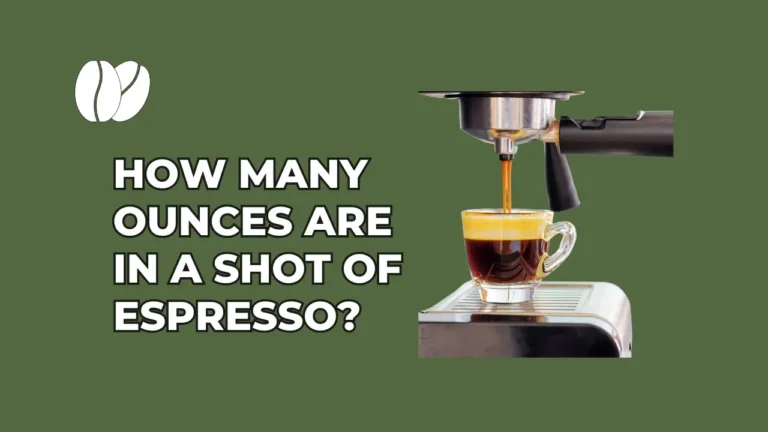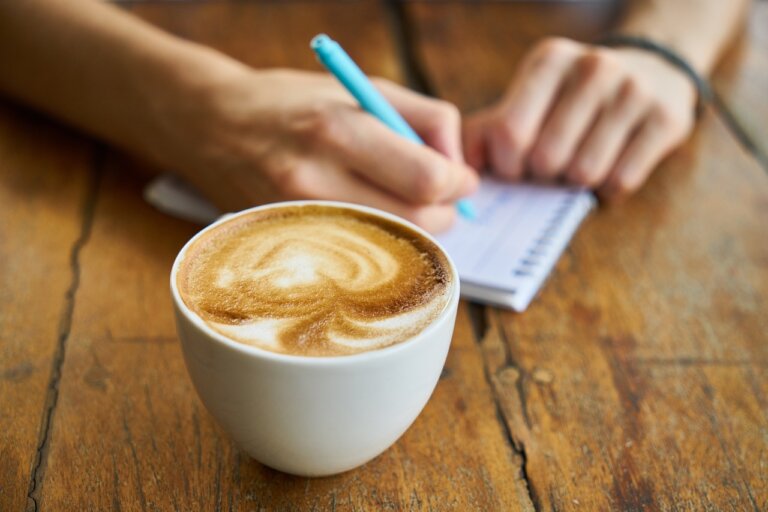Espresso is the base for many variations and the different types of espresso drinks are to improve your coffee experience so you can appreciate the smooth flavors that each espresso type brings.
You may have tried espresso before but these espresso-based drinks will give you more information about espresso and will improve your coffee making.
What Are the Different Types of Espresso Drinks?
Here are the 15 different types of espresso drinks.
1. Espresso
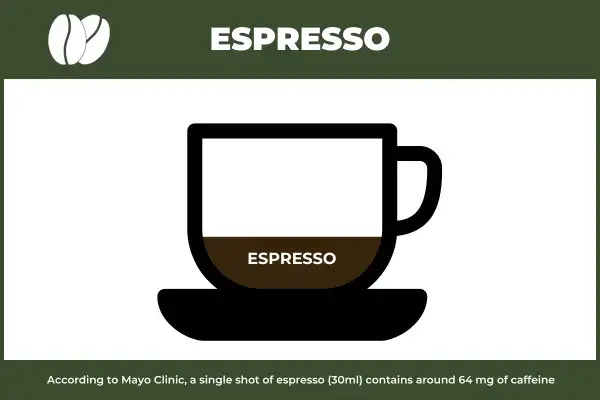
Preparation:
Espresso is the foundation of all espresso-based drinks that we consume which is made by forcing a small amount of nearly boiling water through finely ground coffee beans using its high pressure which is mostly around 9 bars.
Serving Size: 1-2 ounces.
Flavor Profile:
Espresso is known for its bold and intense flavor which is often described as rich and concentrated. It has a thick, almost syrupy texture with a layer of golden crema on top that adds to its smooth mouthfeel
Characteristics:
Espresso is the most concentrated form of coffee which is served as the base for many other drinks. It’s mostly enjoyed on its own in a small cup so people can feel its strong and complex flavors.
2. Doppio
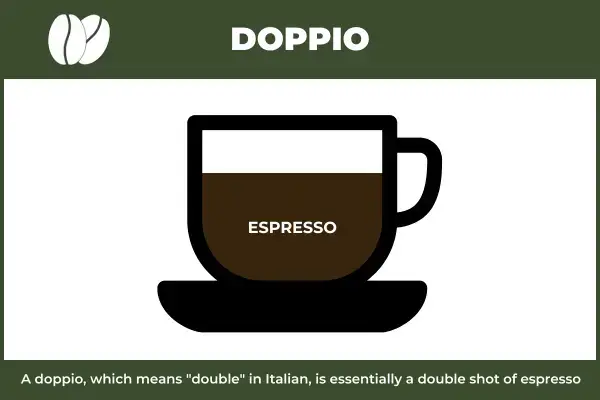
Preparation:
A doppio is simply a double shot of espresso made by using double the amount of coffee grounds and water than a regular espresso.
Serving Size: 2-4 ounces.
Flavor Profile:
The doppio has a stronger and more intense flavor than a single shot of espresso. It’s often preferred by people with a more pronounced coffee experience.
Characteristics:
This drink offers twice the caffeine and flavor intensity of a regular espresso shot which makes it a popular choice for people who like a stronger pick-me-up.
3. Ristretto
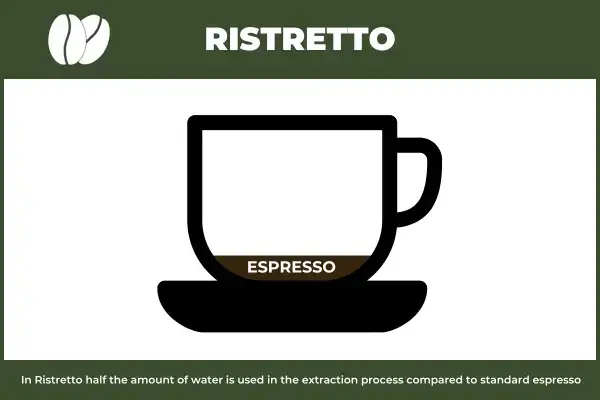
Preparation:
Ristretto is made by using the same amount of coffee grounds as a standard espresso but it has less water. The brewing process is cut short resulting in a “short” shot.
Serving Size: 0.75-1 ounce.
Flavor Profile:
Ristretto has a richer and more concentrated flavor than espresso. It is less bitter with a sweeter and more intense flavor.
Characteristics:
The reduced water and shorter extraction time lead to a thicker and more syrupy consistency. Ristretto is favored by people who like bold and sweet espresso without bitterness in it.
4. Lungo

Preparation:
Lungo means “long” in Italian which is made by pulling an espresso shot with water that is twice as much as a regular espresso.
Serving Size: 2-3 ounces.
Flavor Profile:
The lungo has a milder and more diluted flavor compared to a standard espresso and it can be slightly more bitter due to the extended extraction time.
Characteristics:
Lungo is less concentrated and has a lighter body which is a good choice for people with less intense coffee experience.
5. Macchiato

Preparation:
A macchiato means “stained” or “spotted” in Italian and is an espresso shot “stained” with a small amount of steamed milk or foam.
Serving Size: 1-2 ounces.
Flavor Profile:
The macchiato has a strong espresso flavor which is slightly mellowed by the touch of milk. The milk adds a slight sweetness and creaminess without overwhelming the coffee’s boldness.
Characteristics
This drink is perfect for people who like the strength of espresso but want a hint of creaminess without the dilution of a larger amount of milk.
6. Cappuccino
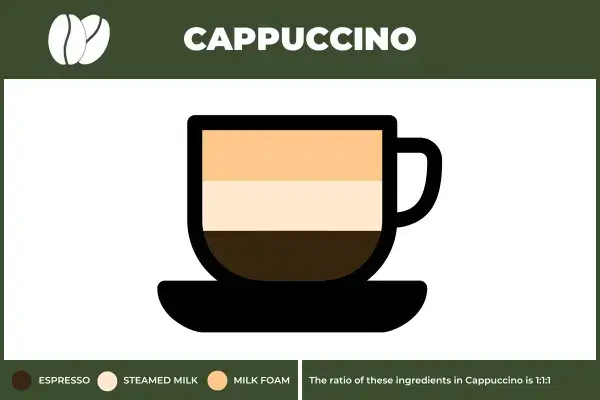
Preparation:
A cappuccino is made with equal parts espresso, steamed milk, and milk foam. It mainly consists of 1/3 espresso, 1/3 steamed milk, and 1/3 foam.
Serving Size: 6 ounces.
Flavor Profile:
Cappuccinos have a rich and creamy texture with the foam providing a light, airy contrast to the bold espresso. The balance of coffee and milk creates a harmonious blend, making it less intense than a straight espresso but still full of flavor.
Characteristics:
Cappuccinos are liked as a morning drink and their frothy top makes them ideal for adding a sprinkle of cocoa powder or cinnamon.
7. Latte

Preparation:
A latte is a short form of “caffè latte” which is made with one shot of espresso and a larger amount of steamed milk topped with a small layer of milk foam. The ratio is mostly 1/3 espresso to 2/3 steamed milk.
Serving Size: 8-12 ounces.
Flavor Profile:
Lattes are smooth and creamy with the milk softening the espresso’s strong flavor. This makes the latte a milder, more accessible coffee option.
Characteristics:
It is adjustable and can be flavored with syrups or spices like vanilla, caramel, or cinnamon. It’s also popular for latte art due to its frothy milk layer.
8. Flat White
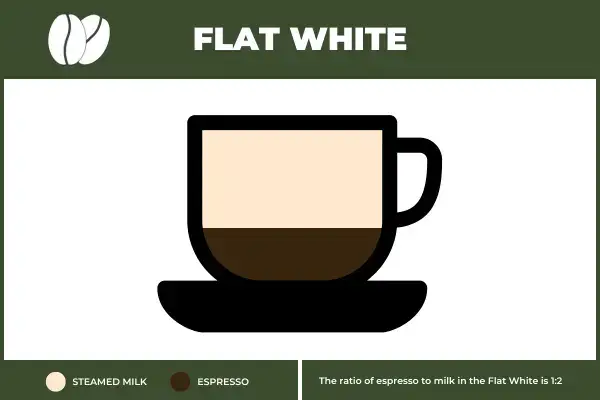
Preparation:
A flat white is similar to a latte but with a higher coffee-to-milk ratio and a velvety microform instead of thick milk froth. The microfoam is made by steaming milk until it has a fine and velvety texture without large bubbles.
Serving Size: 6-8 ounces.
Flavor Profile:
The flat white has a stronger coffee flavor than a latte with a smooth and creamy texture. The microfoam adds a silky mouthfeel that increases the overall experience.
Characteristics:
The flat white is liked for its balanced flavor and creamy texture which makes it a favorite among those who want a stronger coffee flavor without the heaviness of too much milk.
9. Mocha

Preparation
A mocha is a chocolate-flavored latte and is made by combining espresso with steamed milk and chocolate syrup or cocoa powder then topped with whipped cream.
Serving Size: 8-12 ounces.
Flavor Profile:
Mocha is rich, sweet, and indulgent combining the flavors of coffee, milk, and chocolate. The whipped cream adds an extra layer of sweetness and texture.
Characteristics:
The mocha is perfect for people who like both coffee and chocolate. It’s a dessert type of treat that fulfills both caffeine cravings and a sweet tooth.
10. Americano
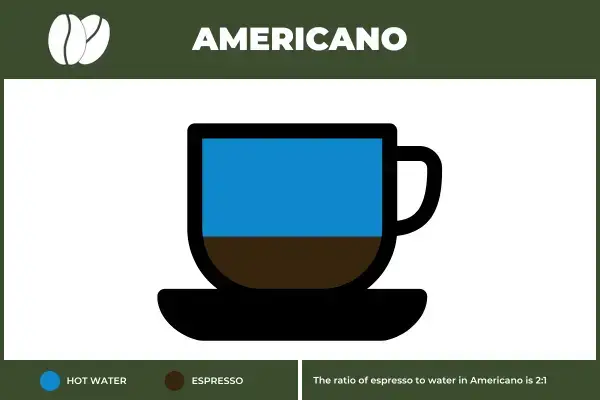
Preparation:
An Americano is made by mixing a shot of espresso with hot water. The ratio of water to espresso can vary but it’s typically around 1:1 or 1:2.
Serving Size: 8-12 ounces.
Flavor Profile:
The Americano has a similar strength to drip coffee but retains the rich and bold flavor of espresso. The addition of water results in a less concentrated and smoother drink.
Characteristics:
The Americano is a versatile and straightforward drink that is enjoyed by those who want the flavor of espresso with the volume of a regular coffee. It’s said that it originated during World War II when American soldiers in Italy would mix their espresso with water to mimic the coffee they were used to back home.
11. Cortado
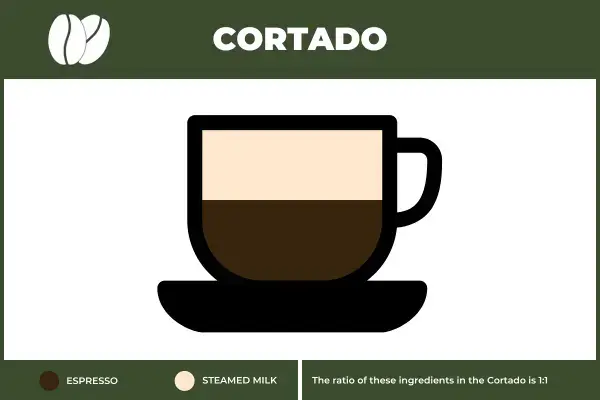
Preparation:
A cortado is made with equal parts of espresso and steamed milk with no foam in it. The milk is added to “cut” the espresso which balances its intensity.
Serving Size: 4-6 ounces.
Flavor Profile:
The cortado has a balanced flavor with the milk softening the espresso’s boldness without taking over it. It’s less creamy than a latte or cappuccino but smoother than a straight espresso.
Characteristics:
The cortado is popular for its simple and balanced taste which gives it the pure taste of espresso with just a touch of milk.
12. Café au Lait

Preparation:
Café au Lait is prepared by mixing brewed coffee with steamed milk in equal parts. It’s similar to a latte but uses drip coffee instead of espresso as the base.
Serving Size: 8-12 ounces.
Flavor Profile:
This drink has a smooth and. mild flavor with the coffee giving a gentle bitterness and the steamed milk adding creaminess. It’s less intense than an espresso-based drink and gives a more balanced and mellow experience.
Characteristics:
Café au Lait is enjoyed by those who prefer a lighter coffee drink with a creamy texture. It’s a popular choice for breakfast or as a comforting and warm beverage.
Which Food Pairs Best with Espresso
1. Chocolate:
Chocolate has a deep and rich flavor of dark chocolate which matches with the bold intensity of espresso. Try to pair it with high-quality dark chocolate for a better experience or with a chocolate dessert like a brownie to increase both the coffee and the chocolate.
2. Pastries:
Pastries are fresh and buttery such as croissants, Danish pastries, and Italian treats. The texture and sweetness balance the espresso’s bitterness and make each sip more enjoyable.
3. Cheese:
Cheese is very soft and creamy like cream cheese which adds a smooth texture and mild flavor that can soften the espresso’s intensity.
4. Nuts:
Nuts like almonds, hazelnuts, or walnuts provide a crunchy texture and nutty flavor that pairs well with espresso. The slightly sweet or savory notes of the nuts give the espresso boldness and create a satisfying contrast.
5. Fruits:
Dried fruits such as figs, apricots, or dates had sweet elements that matched nicely with the espresso’s strong and bitter flavors. These fruits add a touch of natural sweetness and complexity to the tasting experience.
Conclusion
These variations are not only improving your coffee experience but it also gives you opportunities to experiment with different combinations and techniques. Each espresso-based beverage offers a unique taste and texture. Next time you visit a coffee shop or brew coffee at home you’ll know and will enjoy the full spectrum of espresso drinks.

